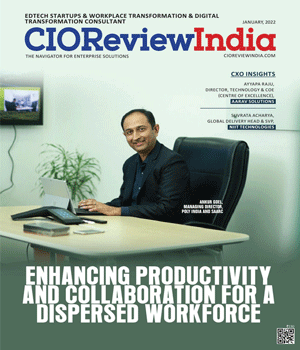
How leveraging technology solutions automates tasks, and streamlines business processes
Bimlesh Prasad | Wednesday, 30 August 2023, 13:13 IST
 In a recent interaction with CIOTechOutlook, Ashish Kothari, Vice President and Partner, Kyndryl Consult shares his views on the potential benefits of leveraging technology and industry solutions for business transformation, common challenges that arise during the transformation of business functions, and more.
In a recent interaction with CIOTechOutlook, Ashish Kothari, Vice President and Partner, Kyndryl Consult shares his views on the potential benefits of leveraging technology and industry solutions for business transformation, common challenges that arise during the transformation of business functions, and more.
Ashish Kothari leads the India practice and P & L for Kyndryl Consult with a focus on Business Strategy and governance, IT modernization and transformation, and next-gen operating models. Previously he worked as the Associate Director for the IT infrastructure services at IBM and was responsible for driving the GTS growth in Enterprise Accounts.
What is the potential benefit of leveraging technology and industry solutions for business transformation?
The rapid pace of digital transformation driven by cloud and AI adoption has given rise to new opportunities and enterprise business models. Leveraging technology solutions not only automates tasks, streamlines processes, and improves efficiency but also enables businesses to make informed decisions, respond quickly to market changes, and gain a competitive edge by launching new products and optimizing costs. However, the key challenge is in determining the nature, speed, and depth of IT modernization that companies should adopt while scaling their businesses for future growth. In the world of digital changes, businesses are now linking technology with their aims, embracing flexibility and expansion. This method works for companies at different digital points, creating specific answers that cover different areas. From smart plans to practical actions, this could be a big shift in the industry powered by technology for real change.
What strategies do you use to help optimize operational activities? What actions would you take to raise the company's standing in the marketplace?
In today's fast-changing business world, we are a reliable partner by your side, offering customized solutions across different areas. Technology partners are great at helping businesses modernize, use new tech, and make things faster with automation. What makes them special is how they blend new technologies smoothly. Whether you are just starting your digital journey or well into it, their advice leads to real progress. With a lot of experience, they are good at dealing with complicated stuff by breaking it into smaller steps. Their main goal is your success. With their know-how, resources, and strong partnerships, they push your business forward in this innovation-driven world.
How do technical advancements influence corporate leadership and industry innovation?
The technology adoption trends during the COVID-19 pandemic are a good example of how innovative ideas and processes helped to rebuild business models overnight. It acted as a catalyst for digital transformation, forcing businesses to rapidly adopt remote working practices and embrace digital technologies. Corporate leadership pivoted to prioritize agility, empathy, and effective virtual communication as core skills in their organizations. Even though the pandemic has abated, the lessons learned, new ways of working, and innovative models will now act as the base for future growth.
In enterprises, leaders play a crucial role in creating an environment that encourages creativity, risk-taking, and collaboration. They must invest in continuous learning programs, encourage upskilling and reskilling, and foster a culture of innovation to attract and retain top talent. Moreover, creating cross-functional teams and enabling collaboration between technical and business professionals helps drive industry innovation.
What are some common challenges that arise during the transformation of business functions?
The complexity of constantly evolving technology trends and knowing how to prioritize their modernization efforts are some of the key challenges for our customers. Another common challenge that organizations face is finding and training employees with the right skillsets. Hiring external experts or partnering with consultants can help identify the right solutions to address these challenges.
For example, Kyndryl's network services team played a crucial role in Tokyo's leading television station, Fuji Television Network by devising and implementing a secure and flexible network infrastructure, overcoming bandwidth limitations, and facilitating seamless remote work capabilities. This enhanced infrastructure empowered the adoption of cloud computing and accommodated evolving employee work styles while also contributing to the station's sustainability objectives. In another significant undertaking, a major airline underwent a comprehensive transformation by migrating its mission-critical workloads to AWS, embracing Red Hat OpenShift on Azure, and implementing a DevSecOps framework. This strategic move not only modernized their legacy systems but also bolstered their operational capabilities, improving resiliency across their technology stack. By doing so, the airline positioned itself for long-term success in a highly competitive industry.
How businesses can benefit from enhanced security measures, including regular system updates, backups, and disaster recovery plans, if they choose to consult an IT infrastructure services provider.
The digitization era has brought about a surge in cyber threats and data breaches, emphasizing the importance of robust cybersecurity measures. However, a protection-based approach is no longer sufficient in the face of evolving security threats. Organizations must adopt a proactive stance toward security. To do so, they need to prioritize cyber resilience, addressing the entire threat lifecycle more efficiently.
Enhanced security measures, such as regular system updates, backups, and disaster recovery plans, offer significant advantages for businesses when they opt to consult an IT infrastructure services provider. The collaboration involves identifying essential business processes, devising backup and recovery strategies, and conducting frequent testing to ensure the plan's effectiveness. This is exemplified by instances like Kyndryl Business Resiliency Services collaborating with the National Stock Exchange (NSE) in India to modernize their IT systems, integrating automation features for improved security and operational resilience.
CIO Viewpoint
EdTech Business Models: Unlocking Success in...
By Atulya Kaushik, Co-founder and CEO of PrepInsta
CIO's Role in Driving Enterprise Sustainability
By Manoj Deorukhkar, Chief Information Officer at Sterling & Wilson Limited
Transforming employee experience through the...
By Prasad Ramakrishnan, CIO of Freshworks
CXO Insights
How leveraging technology solutions automates...
By Bimlesh Prasad
Why Digitalization is Crucial to Staying...
By Janifha Evangeline
How Digitization is Shattering Real Estate...












